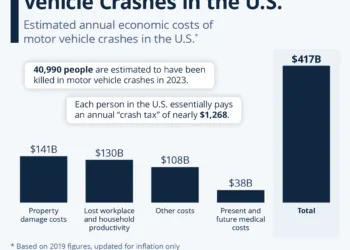Understanding Road Traffic Fatalities: A Global Perspective
Road traffic injuries have drastically altered the landscape of public health, emerging as a leading risk factor for death, particularly among younger populations. This has prompted global organizations to take action, aiming to address and mitigate the factors contributing to these alarming statistics.
The Scope of the Issue
According to the World Health Organization (WHO), a staggering 1.19 million lives are lost to road accidents globally each year. This dizzying number has become a focal point for health agencies and governments alike, with the United Nations General Assembly targeting a 50% reduction in these fatalities by 2030. This ambitious goal underscores the scale of the public health crisis that road traffic injuries pose.
Vulnerable Populations
The demographic most affected by road traffic injuries are individuals aged between 5 and 29 years. Within this age group, road traffic injuries have emerged as the leading cause of death. This alarming trend is compounded by the fact that over half of all road traffic deaths are attributed to vulnerable road users, including pedestrians, cyclists, and motorcyclists. This raises critical questions about urban planning and the need for improved infrastructure that protects these groups.
A Global Crisis with Regional Disparities
While road safety is indeed a global issue, the severity varies drastically across different regions. An alarming statistic reveals that up to 90% of road traffic deaths occur in low- and middle-income countries. The World Bank has indicated that the increase in vehicle ownership in these regions has outpaced improvements in road safety management, infrastructure, and regulatory enforcement.
Spotlight on Fatality Rates: Guinea and Other High-Risk Areas
Recent data from the WHO has spotlighted Guinea as the country with the highest road traffic death rate, recording 37 deaths per 100,000 inhabitants in 2021. Following closely are Libya and Haiti with rates of 34 and 31 deaths per 100,000 respectively. The alarming trend in these countries highlights a pressing need for intervention and better road safety practices.
The African Continent: A Particularly Dangerous Landscape
Africa stands out with the highest road traffic death rates globally, claiming 12 of the 20 deadliest countries for road deaths. With such staggering figures, there is an urgent call to action for governments and organizations to invest in road safety measures tailored to the unique challenges faced in these regions.
A Comparison: Developed versus Developing Nations
In stark contrast, the United States registered approximately 14 road traffic deaths per 100,000 population in 2021, ranking 79th in the world for road fatalities. This comparative perspective highlights the disparity in road safety measures, enforcement of traffic laws, and overall infrastructure quality between more developed nations and those still grappling with such fundamental issues.
Key Takeaways
The data presents a sobering reality that road safety is a multifaceted challenge requiring concerted efforts from various stakeholders. Understanding the geographic disparities in road safety can help shape policies and interventions aimed at reducing fatalities and creating safer roadways for all users.












